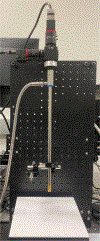A dual-camera hyperspectral laparoscopic imaging system
- PMID: 38708175
- PMCID: PMC11069412
- DOI: 10.1117/12.3005893
A dual-camera hyperspectral laparoscopic imaging system
Abstract
Minimally invasive surgery (MIS) has expanded broadly in the field of abdominal and pelvic surgery. However, there are still prevalent issues surrounding intracorporeal surgery, such as iatrogenic injury, anastomotic leakage, or the presence of positive tumor margins after resection. Current approaches to address these issues and advance laparoscopic imaging techniques often involve fluorescence imaging agents, such as indocyanine green (ICG), to improve visualization, but these have drawbacks. Hyperspectral imaging (HSI) is an emerging optical imaging modality that takes advantage of spectral characteristics of different tissues. Various applications include tissue classification and digital pathology. In this study, we developed a dual-camera system for high-speed hyperspectral imaging. This includes the development of a custom application interface and corresponding hardware setup. Characterization of the system was performed, including spectral accuracy and spatial resolution, showing little sacrifice in speed for the approximate doubling of the covered spectral range, with our system acquiring 29 spectral images from 460-850 nm. Reference color tiles with various reflectance profiles were imaged and a RMSE of 3.56 ± 1.36% was achieved. Sub-millimeter resolution was shown at 7 cm working distance for both hyperspectral cameras. Finally, we image ex vivo tissues, including porcine stomach, liver, intestine, and kidney with our system and use a high-resolution, radiometrically calibrated spectrometer for comparison and evaluation of spectral fidelity. The dual-camera hyperspectral laparoscopic imaging system can have immediate applications in various surgeries.
Keywords: Hyperspectral imaging; image-guided intervention; laparoscopy; minimally invasive surgery.
Figures





References
Grants and funding
LinkOut - more resources
Full Text Sources
